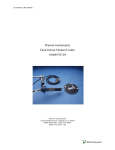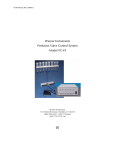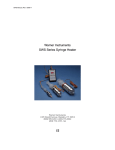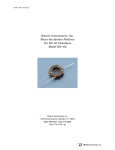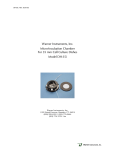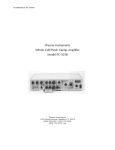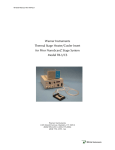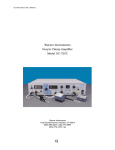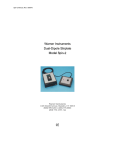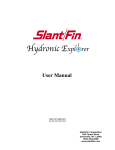Download CL-200 Manual - Warner Instruments
Transcript
CL-200 Manual, Rev. 097014 Warner Instruments Dual-Channel Bipolar Temperature Controller Model CL-200 Warner Instruments 1125 Dixwell Avenue, Hamden, CT 06514 (800) 599-4203 / (203) 776-0664 (203) 776-1278 - fax CL-200 Manual, Rev. 097014 Table of Contents INTRODUCTION....................................................................................................................................... 4 NOMENCLATURE.................................................................................................................................... 5 Text conventions ..................................................................................................................................... 5 CONTROL DESCRIPTION...................................................................................................................... 6 Front panel .............................................................................................................................................. 6 Power Switch (Item A).......................................................................................................................... 6 Meter Selector Switch and Meter (Item B) ........................................................................................... 6 Cooling Mode Switch (Item C)............................................................................................................. 7 Thermistor Recorder Outputs (Items E, V)........................................................................................... 7 Monitor Temp In BNC (Item F)............................................................................................................ 7 Loop Speed Switch (Item G)................................................................................................................. 7 Set Temperature Control (Item H) ....................................................................................................... 7 External/Internal Select Control (Item J)............................................................................................. 7 Manual Voltage Control (Item K) ........................................................................................................ 7 Peltier Limit LED (Item L) ................................................................................................................... 8 Freeze Alert LED (Item M) .................................................................................................................. 8 Heat / Cool LED’s (Item N) ................................................................................................................. 8 Current Limit LED (Item O)................................................................................................................. 8 Thermistor Impedance Selector Switch (Item P).................................................................................. 8 Heat Loss Compensation Dial (Item Q) ............................................................................................... 8 Feedback Thermistor Selector Switch (Item R).................................................................................... 8 Thermistor Open LED (Item S) ............................................................................................................ 8 Rear panel ............................................................................................................................................... 9 External Volts Set (Item T) ................................................................................................................... 9 External Temp Set (Item U).................................................................................................................. 9 Heater/Cooler input (Item W) .............................................................................................................. 9 Power Entry Module (Item Y) .............................................................................................................. 9 Ground Terminals (Item X) .................................................................................................................. 9 SETUP........................................................................................................................................................ 10 Warner Peltier Driven Systems........................................................................................................... 10 Operating With Other Equipment...................................................................................................... 10 Warner Resistive Heating Systems ..................................................................................................... 10 Third-party Equipment ....................................................................................................................... 10 Thermistor Considerations................................................................................................................. 10 OPERATION ............................................................................................................................................ 11 AUTOMATIC MODE ......................................................................................................................... 11 CL-200 Manual, Rev. 097014 Heat Loss Compensation ..................................................................................................................... 11 Feedback Thermistor Selection........................................................................................................... 12 MANUAL MODE................................................................................................................................. 13 APPENDIX................................................................................................................................................ 14 Specifications......................................................................................................................................... 14 Accessories and replacement parts ..................................................................................................... 14 Warranty and service........................................................................................................................... 15 Warranty............................................................................................................................................. 15 Service notes....................................................................................................................................... 15 Certifications......................................................................................................................................... 16 4 CL-200 Manual, Rev. 090714 The CL-200 Dual-Channel Bipolar Temperature Controller from Warner Instruments is a versatile and user-friendly thermal control device. This dual-channel automatic temperature controller is capable of accurately maintaining two Peltier devices between -6°C and 65°C. The unit will also maintain a resistive heater from ambient to 65°C. While specifically designed for use with Warner’s Heating/Cooling Platforms and In-Line Solution Heater/Coolers, this instrument can be easily adapted for use with custom-built equipment according to the requirements of the user. When coupled with the SC-20 Dual In-line Solution Heater/Cooler, the CL-200 provides efficient control of perfusion solution temperatures. The unit is simple to use with a single control for temperature adjustment. Total automatic control is provided in automatic mode, while manual control is available in manual mode. A loop-speed selector is used to optimize the response of the system to accommodate thermal delay characteristics intrinsic to the setup. Features of the CL-200 include 9 Quiet operation suitable for use in sensitive electrophysiology applications 9 Automatic and manual modes 9 Single control temperature adjustment 9 Freeze alert 9 Built-in protection for Peltier devices 9 Selectable loop speed optimizes system speed and stability 9 Simultaneous monitoring of system temperature and a separate point of interest 9 Heat Loss compensation mode 9 Open thermistor fault protection 9 External inputs for computer control 9 Compatible with all Warner Peltier-driven Heater/Cooler devices THIS EQUIPMENT IS NOT DESIGNED NOR INTENDED FOR USE ON HUMAN SUBJECTS Warner Instruments A Harvard Apparatus Company 5 CL-200 Manual, Rev. 090714 NOMENCLATURE Text conventions This manual refers to instrument controls at two functional levels; specific controls and settings of these controls. To increase readability, we employ the following text conventions. Since our goal is to provide clarity rather than complexity, we welcome any feedback you may wish to provide. ¾ Warner Instrument product model numbers are presented using bold type. ¾ References to controls are specified using SMALL CAPS. ¾ References to control settings are specified using italic type. ¾ Special comments and warnings are presented in highlighted text. Any other formatting should be apparent from context. Warner Instruments A Harvard Apparatus Company 6 CL-200 Manual, Rev. 090714 CONTROL DESCRIPTION Front panel A labeled image of the face panel for one channel of the CL-200 is shown below. Operating components are identified by letters. Refer to this diagram as an aid in identification of the described components. Power Switch (Item A) Supplies power to the CL-200. Meter Selector Switch and Meter (Item B) THE SELECTOR SWITCH selects the parameter displayed on the associated METER. Included options are HLC Temp, Set Temp, Control Temp (T1), Monitor Temp (T2), Output Volts, and Output Amps and are described below. Set Temp reports the adjustment from either the SET TEMPERATURE control (Item H) or the EXT TEMP SET BNC (Item Q). Displayed units are °C. Control Temp reports the actual temperature of the feedback thermistor situated within the heater/cooler device being used. Displayed data is informative only and is in units of °C. HLC Temp reports the heat loss compensated temperature of a “phantom” thermistor at the site of interest. Displayed data is informative only and is in units of °C. Monitor Temp reports the temperature of the sensor thermistor which connects via the MONITOR TEMP IN BNC (Item F). This provides a convenient means to determine the temperature of any point of interest within your configuration. Displayed units are °C. Output Volts reports the adjustment from either the MANUAL VOLTAGE control (Item K) or the EXT VOLT SET BNC (Item T). Displayed units are Volts. Warner Instruments A Harvard Apparatus Company 7 CL-200 Manual, Rev. 090714 Output Amps reports the current output command associated with either the MANUAL (Item K) or the EXT VOLT SET BNC (Item T). Displayed units are Amperes. VOLTAGE control The METER also provides an indication that the main POWER is on. Cooling Mode Switch (Item C) Selects between Automatic or Manual operational modes, or center select for off. Thermistor Recorder Outputs (Items E, V) BNC connectors are provided to send thermistor readings to a data acquisition system or chart recorder. MONITOR TEMP OUT (Item E) reports the temperature of the sensor thermistor which connects via the MONITOR TEMP IN BNC (Item F). Output is calibrated to 100 mV/°C. CONTROL TEMP OUT (Item V, back panel) reports the actual temperature of the feedback thermistor situated within the heater/cooler device being used. Output is calibrated to 100 mV/°C. Monitor Temp In BNC (Item F) BNC for connecting a sensor thermistor used to sample the temperature at a point of interest. This input is designed for use with the TA-29 cable assembly. Loop Speed Switch (Item G) This switch sets the feedback loop speed for the CONTROL TEMP THERMISTOR when the CL-200 is used in automatic mode. Feedback options include fast, medium, and slow. Optimally set to fast for most applications but can be set to medium or slow for systems with longer thermal delay characteristics. For example, use the medium speed for use with the SC-20 Bipolar In-Line Solution Heater. Set Temperature Control (Item H) This dial adjusts the set point of the automatic temperature control system. The associated GREEN LED is on when the INTERNAL/EXTERNAL SELECT CONTROL (Item J) is set to internal, and the COOLING MODE SWITCH (Item C) is set to auto. Set value can be read from the METER (Item B) in the set temp position. External/Internal Select Control (Item J) This switch selects between internal or external control inputs when the instrument is in Manual mode (Item C). When the INTERNAL/EXTERNAL SELECT CONTROL is set to internal, and the COOLING MODE SWITCH (Item C) is set to auto, the SET TEMPERATURE CONTROL (Item H) will be active. Setting the COOLING MODE SWITCH (Item C) to manual disables the SET TEMPERATURE CONTROL (Item H) and activates the MANUAL VOLTAGE CONTROL (Item K). Manual Voltage Control (Item K) This dial is used to manually adjust the voltage output to the heater/cooler device. The associated GREEN LED is on when the INTERNAL/EXTERNAL SELECT CONTROL (Item J) is set to Warner Instruments A Harvard Apparatus Company 8 CL-200 Manual, Rev. 090714 internal, and the COOLING MODE SWITCH (Item C) is set to manual. Set value can be read from the METER (Item B) in the output volts position. Peltier Limit LED (Item L) This option functions only when the CL-200 is used with an SC-20 Dual In-line Solution Heater/Cooler. The RED LED is lit when the temperature of the Peltier device within the SC-20 exceeds its operational limits. Activation of this circuit automatically sets the output voltage of the CL-200 to 0 V. Freeze Alert LED (Item M) This option functions only when the CL-200 is used with an SC-20 Dual In-line Solution Heater/Cooler. The BLUE LED is lit when the Peltier device within the SC-20 approaches 0°C. Activation of this circuit is informative only and will not alter any instrument setting. Heat / Cool LED’s (Item N) RED and BLUE LED’S indicate heating or cooling power applied to the Peltier device. Current Limit LED (Item O) This indicator light informs the user that the channel has reached the maximum current output of 5 Amperes. This indicator is informative only, and will not alter the function or settings of the device. Thermistor Impedance Selector Switch (Item P) This switch can be set to indicate the type of thermistor in use with the peripheral device. The thermistor impedance for Warner Instruments equipment is 10kΩ @ 25˚C, while the thermistor impedance for Harvard equipment is 100kΩ @ 25˚C. Heat Loss Compensation Dial (Item Q) This dial can be used in auto mode as an adjustment for the temperature gradient between T1 and T2. This circuit utilizes the change in power output to adjust for the heat lost from the system and maintain a stable temperature at the preparation. Feedback Thermistor Selector Switch (Item R) This switch can be set to select the thermistor that will be used as the control point for the feedback regulation of set temperature. Thermistor Open LED (Item S) This LED indicator will signify an open thermistor circuit (broken thermistor wire). Warner Instruments A Harvard Apparatus Company 9 CL-200 Manual, Rev. 090714 Rear panel A schematic of the rear panel of the CL-200 is shown below. Important components are identified by letter (T-Y). Refer to this diagram as an aid in identification of the described components. External Volts Set (Item T) Input BNC for the application of a specified voltage to be applied to the heater/cooler being controlled. Input functions only when the INTERNAL/EXTERNAL SELECT CONTROL (Item J) is set to external, and the COOLING MODE SWITCH (Item C) is set to manual. Units are 1 V/V input. This input can be used for computer control purposes. External Temp Set (Item U) Input BNC for adjusting the SET TEMPERATURE of the CL-200. Input functions only when the INTERNAL/EXTERNAL SELECT CONTROL (Item J) is set to external, and the COOLING MODE SWITCH (Item C) is set to auto. Units are 100 mV/°C. This input can be used for computer control purposes. Heater/Cooler input (Item W) This is the connection port for Warner Heater/Cooler devices such as the SC-20 Dual Inline Heater/Cooler and QE-1HC Heating/Cooling Platform. Power Entry Module (Item Y) Comprised of the line cord attachment point, line voltage selector and fuse buss. Power entry is selectable between 115 VAC, 60 Hz or 230 VAC, 50 Hz. The replaceable fuse is 0.4 amp slow-blow for 230 V applications, or 0.8 amp “slow-blow” for 115 V applications. Ground Terminals (Item X) Provides separate connections for chassis and circuit ground. Banana jacks are bridged when shipped from the factory. Warner Instruments A Harvard Apparatus Company CL-200 Manual, Rev. 090714 10 SETUP The CL-200 has been designed primarily to drive Warner’s expanding line of Peltier-driven heating and cooling devices. However, the instrument is also capable of supplying power to Warner’s line of resistive heaters (Series 20 heater platforms, in-line solution heaters, etc.). The instrument will auto-detect when a resistive-only heating device has been attached and will disable cooling commands. Warner Peltier Driven Systems The set up for the CL-200 is straightforward when used with a Peltier driven heater/cooler. First connect the cable from the heater/cooler into the 15-pin D-connector on the back of the CL-200. Then connect the TA-29 thermistor (supplied with the heater/cooler) to the MONITOR TEMP IN BNC (Item F). If using the SC-20 in-line solution heater/cooler, set the CL-200 loop speed to medium. If using a different device, then set the loop speed to the setting specified in that devices user’s manual, or initially set the loop speed to fast and adjust as necessary to achieve stable performance. If using external control inputs, make connections from your command output (e.g., analog out on the A/D board or a power supply) to either the EXT TEMP SET (Item U) or EXT VOLT SET (Item T) BNC’s on the rear panel. Operating With Other Equipment The CL-200 can be used to power other Warner equipment such as the SH-27B and SF-28 inline solution heaters. In addition, the controller can be used as an independent device to power thirdparty equipment so long as the following considerations are met. Warner Resistive Heating Systems Use of the CL-200 to power Warner resistive heaters is permitted if used in conjunction with the AC-100 adapter cable. When the CL-200 is connected to a resistive device, all command inputs (auto and manual modes for both internal and external commands) are functional with the exception that cooling commands are not executed. Third-party Equipment The CL-200 heater controller will work with many other heating devices if used in conjunction with the AC-100 adapter cable. To obtain maximum heating power, the resistance of the third-party heating element should be between 8-12 Ω. However, any element that works at a maximum of 15 V and 2.4 A will also work with the CL-200. Thermistor Considerations The CL-200 heater controller is designed to accommodate Unical thermistors from Thermometrics (Edison, New Jersey). This family of thermistors can be interchanged without recalibration of the instrument. The nominal resistance of a Unical thermistor is 10.0 kΩ at 25°C. Other thermistors may be used with the CL-200 if the nominal resistance is also 10.0 kΩ at 25°C. Warner Instruments A Harvard Apparatus Company CL-200 Manual, Rev. 090714 11 OPERATION The main use of a heater/cooler control device such as the CL-200 is to maintain a constant bath temperature with minimum deviation from a set temperature. This is usually achieved by using a thermally controlled chamber/platform or in-line solution heater, or a combination of both. NOTE: Refer to the front and rear panel schematics on pages 6-9 for orientation of the CL-200 controls. AUTOMATIC MODE In Automatic Mode, the CL-200 maintains the temperature of the connected heater/cooler at the value set by the user. Operation is straightforward. Connect your heater/cooler device and sensor thermistor as described on page 10. Set the CL-200 to internal commands by setting the INTERNAL/EXTERNAL SELECT control (Item J) to internal. Place the CL-200 into auto mode by switching the COOLING MODE SWITCH (Item C) to auto. Switch the METER (Item B) to Set Temp and adjust to the desired set-point using the SET TEMPERATURE control (Item H). Alternatively, the CL-200 can be commanded using external inputs. Set the CL-200 to external commands by setting the INTERNAL/EXTERNAL SELECT control (Item J) to external. In this mode the CL-200 will accept external temperature settings from the EXT TEMP SET BNC (Item U) on the instrument rear panel. This input is calibrated to 100 mV/°C. The selectable LOOP SPEED control (Item G) is used to adjust the speed of the feedback loop in the heater/cooler-thermistor system, which controls the rate of change of the CL-200 output voltage. Non-Warner heater systems with feedback thermistors can be used in automatic mode provided they are compatible with the CL-200 requirements. LOOP SPEED is normally set to fast to provide the shortest cycle time between the application of power to the heater element and the sensing of temperature at the thermistor. For heater/coolerthermistor systems with long response times, such as with Warner’s SC-20 in-line solution heater/cooler, the fast setting will cause the temperature to overshoot the target resulting in system oscillation. For this condition, try medium or slow settings to find a more optimal feedback rate. Heat Loss Compensation An additional control sets the amount of HEAT LOSS COMPENSATION. This allows the CL-200 to control the temperature at a location downstream from the heater or cooler, where there is heat transferred to the environment. By setting the amount of correction for the heat loss, the Control Thermistor can control the temperature as if there were a “phantom” thermistor at the location of interest. Changes in the Temperature Setting or the thermal load will be corrected, and be reflected in the “Compensated Set Temperature” as displayed on the front-panel meter. Meanwhile, the temperature at the point of interest will be maintained. The amount of Heat Loss Compensation needed will vary with each setup. With the HEAT LOSS COMPENSATION control set fully off (counterclockwise), the set-temperature is maintained at the control thermistor. Heat loss (or gain in the case of cooling) at the location of the experiment will cause a temperature closer to ambient than is desired for that set-temperature. Adjusting the settemperature further from the ambient temperature will correct for this loss, but any change in Warner Instruments A Harvard Apparatus Company 12 CL-200 Manual, Rev. 090714 conditions will cause a new error. If the temperature is instead changed using the HEAT LOSS COMPENSATION control, then changes in perfusion rate or input fluid temperature will be compensated. Changes in ambient temperature or set-temperature will also be compensated. With the METER SELECT switch set to “Set Temp”, the desired temperature is displayed on the panel meter. Changing the meter select switch to “Compensated Set Temp” shows the temperature at the heating device needed to heat the point of interest to the “Set Temp” temperature. Adding heatloss compensation is similar to moving the control thermistor away from the heating or cooling source. This slows the forward loop speed in the feedback system, reducing the stability of the overall system. This makes it desirable to keep the heat path as short as possible. If the perfusion path is too long or the chamber losses to the atmosphere are too great, then the compensation will not be stable. The time needed to stabilize this temperature will be longer than the time to stabilize at a temperature without the compensation. Also, if changes in conditions occur quickly, then the system will need time to make the corrections. Feedback Thermistor Selection A FEEDBACK THERMISTOR switch allows the user to select which thermistor is used for the control loop. Choosing T1 (control thermistor) sets the peripheral’s internal thermistor to control the feedback loop. Selecting T2 (monitor thermistor) allows feedback control at the location of the monitor thermistor, as selected by the user. Note that when T2 is selected as the feedback thermistor, the HEAT-LOSS COMPENSATION function is disabled. The standard CONTROL THERMISTOR is the sensor located in the heating/cooling device. This sensor is placed at the optimal point to control the temperature of the heating/cooling device. The MONITOR THERMISTOR is the peripheral thermistor that can be used to monitor the temperature at another location in the experimental configuration. This thermistor monitors the temperature at the selected point in the experiment and is more accurate but is less stable in the control loop because of the delay between heating (or cooling) and sensing. To protect the experiment if the monitor thermistor is removed, the limit of the increase in temperature between the control and monitor thermistors in the feedback loop is 8˚C. This lowers the probability of overheating the experiment to the point of damage. There is no protection from overcooling caused by a misplaced monitor thermistor. A switch above the T2 INPUT CONNECTOR provides selection of the thermistor impedance for both the control thermistor (T1) and the monitor thermistor (T2) for that channel. The thermistor impedance for Warner Instruments equipment is 10kΩ @ 25˚C, while the thermistor impedance for Harvard equipment is 100kΩ @ 25˚C. An indicator on the front panel indicates an open-thermistor fault of the selected feedback thermistor. Normally, if a thermistor becomes open, as in a broken wire, the controller sees this as a lower temperature. The controller will then increase the output power to try to raise the temperature. This can cause overheating of the experiment if the fault is not noticed. In the CL-200, the selected feedback thermistor is monitored for an open condition. If an open fault is detected, the output power is shut off, preventing overheating. A red LED indicates the presence of an open thermistor. Warner Instruments A Harvard Apparatus Company 13 CL-200 Manual, Rev. 090714 MANUAL MODE In manual mode, the MANUAL VOLTAGE control (Item K) is used to set the output voltage to a fixed value. In manual mode, the SET TEMPERATURE control (Item H) is disabled, as is the feedback system of the CL-200. Operation is again straightforward. Set the CL-200 to accept internal commands by setting the INTERNAL/EXTERNAL SELECT control (Item J) to internal. Place the CL-200 into manual mode by switching the COOLING MODE SWITCH (Item C) to manual. Switch the METER (Item B) to Output Volts and adjust to the desired set-point using the MANUAL VOLTAGE control (Item K). Alternatively, the CL-200 can be commanded using external inputs. Set the CL-200 to external commands by setting the INTERNAL/EXTERNAL SELECT control (Item J) to external. In this mode the CL-200 will accept external voltage commands at the EXT VOLT SET BNC (Item T) located on the instrument rear panel. In this mode, the instrument operates as a 0-15 VDC power supply that can provide up to 2.4 A of current to a device. Use this mode with heater systems that will operate properly with a fixed voltage and lack of feedback thermistors. The CL-200 has a convenient feature for switching modes. In the CL-200, the control loop integrator is held at its last value when switching to off, allowing the integrator to resume when the Automatic mode is again selected. When the CL-200 is switched to manual mode, the integrator tracks the manual voltage. When the mode is set from manual to off, this value is held. Switching to automatic mode allows the control loop integrator to begin at the last voltage setting of the manual mode. This allows the user to set the integrator to any desired initial value for the automatic mode. Warner Instruments A Harvard Apparatus Company 14 CL-200 Manual, Rev. 090714 APPENDIX Specifications Maximum Output Voltage ±15 V Heat/Cool, 0 to 15 V Heat-Only Maximum Output Current 5.0 Amperes DC per channel Manual Voltage Range 0 to 15 VDC Maximum Output Power 75 Watts @ 3Ω Load Each Channel Power Requirements 100-130 or 200-260 VAC, 50/60 Hz, 80 VA Power Fuse (5 x 20 mm ) 0.8 A Slow-Blow for 100-130 VAC 0.4 A Slow-Blow for 200-260 VAC Front Panel Input External thermistor (BNC, calibrated to 10.0 kΩ at 25°C ) Recorder Outputs Monitor Temp Out (BNC, 100 mV/°C ) Control Temp Out (BNC, 100 mV/°C ) Rear Panel Inputs External Temperature Set (BNC, 100 mV/°C ) External Voltage Set (BNC) Heater/Cooler Device (15-pin D connector) Temperature Range Peltier: -6 ˚C to 65 ˚C Resistive: Ambient to 65 °C Meter Display; Resolution 3 digit LED display of °C or V 0.1 ˚C / 0.01 Volt / 0.01 Ampere Meter Readouts Set temperature (°C ) Control Temperature (°C ) Monitor Temperature (°C ) Output Voltage (V ) Output Current (A) Heat Loss Compensation Temp (°C ) Enclosure 8.9 X 42.6 X 29.2 cm (W x H x D) Weight 10 lb (4.54 Kg) Operating conditions: Ambient temperature: 0 to 40 °C Altitude: sea level to 2000 m Relative humidity: 0-95% Equipment is intended to be operated in a controlled laboratory environment. Accessories and replacement parts Model number Order number Description ACC-1 64-1427 Adapter cable for heater only components Warner Instruments A Harvard Apparatus Company 15 CL-200 Manual, Rev. 090714 Warranty and service Warranty The model CL-200 is covered by our Warranty to be free from defects in materials and workmanship for a period of two years from the date of shipment. If a failure occurs within this time, we will either repair or replace the faulty component(s). This warranty does not cover instrument failure or damage caused by physical abuse or electrical stress (inputs exceeding specified limits). In the event that instrument repairs are necessary, shipping charges to the factory are the customer's responsibility. Return charges will be paid by Warner Instruments, Inc. Normal business hours are 8:30 AM to 5:30 PM (EST), Monday through Thursday and 8:30 AM to 5:00 PM on Friday. Our offices are located at 1125 Dixwell Avenue, Hamden, CT 06514, and we can be reached by phone at (800) 599-4203 or (203) 776-0664. Our fax number is (203) 776-1278. In addition, we can be reached by e-mail at [email protected] or through our Web page at http://www.warneronline.com. Service notes Please refer all questions regarding service to our Engineering Department. A) If the instrument POWER light fails to light, check the fuse at the rear panel (located in the black POWER INPUT MODULE). If the fuse is found to be defective replace it with a 5x20 mm, 0.8 A, slow-blow fuse (0.4 A for facilities using 220-240 V line voltages). If the replacement fuse also fails, please call Warner Instruments for assistance. B) Occasionally, a knob on the front panel will loosen after long use. These are "collet" style knobs and are tightened with a screw located under the knob cap. To gain access to the adjustment screw, pry the cap off with a thin bladed screwdriver or similar tool. C) Should service be required, please contact the factory. The problem may often be corrected by our shipping a replacement part. Factory service, if required will be expedited to minimize the customer inconvenience. D) Instruments are inspected immediately upon receipt and the customer is notified if the repair is not covered by the warranty. Repairs can often be completed in 1-2 days from our receipt of the instrument. E) If factory service is required, please observe the following instructions: 1) Package the instrument with at least 3 inches of cushioning on all sides. Use the original shipping carton if it is available. 2) Insure the shipment for its full value. 3) Include with the shipment an explanation of the problem experienced. IMPORTANT for customers outside of the U.S.: Please contact us before return shipping any goods. We will provide instructions so that the shipment will not be delayed or subject to unnecessary expense in clearing U.S. Customs. Warner Instruments A Harvard Apparatus Company 16 CL-200 Manual, Rev. 090714 Certifications Declaration of Conformity CE MARKING (EMC) Application of Council Directive: 89/336/EEC Standards To Which Conformity Is Declared: EN55022 Class A EN61000-3-2 EN61000-3-3 EN50082-1:1992 EN61000-4-2 EN61000-4-3 ENV50204 EN610000-4-4 EN610000-4-8 EN610000-4-11 Manufacturer’s Name: Warner Instruments, LLC Manufacturer’s Address: 1125 Dixwell Avenue Hamden, CT 06514 Tel: (203) 776-0664 Equipment Description: Power Controller Equipment Class: ITE-Class A Model Numbers: CL-200 I the undersigned, hereby declare that the equipment specified above, conforms to the above Directive(s) and Standard(s). Place: Hamden, Connecticut USA Signature: Full Name: Burton J. Warner Position: President Warner Instruments A Harvard Apparatus Company 17 CL-200 Manual, Rev. 090714 Declaration of Conformity CE MARKING (LVD) Application of Council Directive: 73/23/EEC Standards To Which Conformity Is Declared: EN61010-1:1993 Manufacturer’s Name: Warner Instruments, LLC Manufacturer’s Address: 1125 Dixwell Avenue Hamden, CT 06514 Tel: (203) 776-0664 Equipment Description: Equipment Class: Power Controller Safety requirements for electrical equipment for measurement and laboratory use Class I Model Numbers: CL-200 I the undersigned, hereby declare that the equipment specified above, conforms to the above Directive(s) and Standard(s). Place: Hamden, Connecticut USA Signature: Full Name: Burton J. Warner Position: President Warner Instruments A Harvard Apparatus Company CL-200 Manual, Rev. 090714 18 Warner Instruments A Harvard Apparatus Company




















